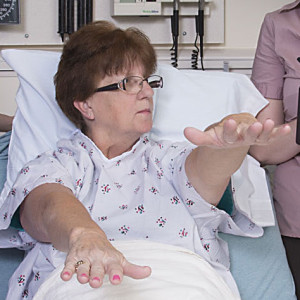 The following is an update to a story published in June 2014 in the Health
First Center Newsletter, “Stroke Robot Saves Lowman”
The following is an update to a story published in June 2014 in the Health
First Center Newsletter, “Stroke Robot Saves Lowman”
“It’s not every day that you get to go to the United States
Capitol and tell lawmakers in congress about how a robot saved your life,”
said Nancy Lowman, CVMC Distribution Technician. “I’m nervous,
but it’s such an honor, and I see this as my chance to help others
have access to life-saving technology.”
Nancy will be in Washington D.C. on Wednesday, May 20 to speak during a
congressional briefing about the power of telestroke and how a partnership
between CVMC and Wake Forest Baptist Health in Winston-Salem, NC saved
her life last year. When Nancy had a stroke, the emergency medical staff
in Hickory used a robot with interactive video conferencing technology
to work together quickly to assess Nancy’s symptoms and make the
critical decision to give her t-PA, a life-saving clot-busting medication.
Nancy and CVMC Emergency Department nurse Danielle Thurman will travel
to the nation’s capitol as guests of the American Stroke Association
to speak at a congressional briefing about the successful outcome Nancy
experienced with the advanced technology. The goal of the briefing is
to help remove barriers that rob other patients of the same timely and
effective treatment that Nancy received. Lengthy travel times to primary
stroke centers and a shortage of neurologists make telemedicine partnerships
an economical option that reduces long-term disabilities and death among
stroke patients. The clot-busting medication, tissue plasminogen activator
(t-PA), has considerably improved stroke treatment, but the medication
must be administered within three hours of the onset of symptoms in order
to be most effective. The drug also carries some risk and may not be appropriate
for all patients.
Stroke is a leading cause of death and long-term disability and has a devastating
social and economical impact across the nation. Many times when patients
arrive at community hospitals, there is little or no access to neurologists
or skilled stroke care experts. Telestroke offers a cost-effective way
to leverage scarce professional resources and minimize the need to transfer
patients to larger hospitals.
“I was told that if I had waited 30 minutes more, I would have most
likely been paralyzed and the damage may have been permanent,” said Nancy.
Many stroke patients require expensive long-term rehabilitation in nursing
homes. Instead, Nancy regained all functionality within 48 hours after
her stroke and returned to her job at the hospital where she has worked
for 20 years just two weeks later. According to an American Heart Association
/ American Stroke Association analysis prepared for the Congressional
Budge Office, expanded use of telestroke can save federal health programs
$119 million per year if lawmakers grant more access to robotic telestroke
consultations and faster administering of t-PA.
“…a rolling robot topped by a video monitor rolled into the
Emergency Room and Rayetta (Johnson) in Winston started examining. She
could see that one side of my face was drooping, my speech was slurring
and I couldn’t open my left eye. She asked me to follow some simple
commands while she also could look at the brain scans the doctors in Hickory
had just ordered. Then she told me that I needed the clot bustingdrug t-PA…”
Stroke awareness, prevention, treatment and recovery are a primary emphasis
at CVMC. While fewer than 20 percent of major US hospitals are stroke
certified, CVMC recently received renewal of its designation as a
Primary Stroke Center by The Joint Commission that was first obtained in 2013. #telestroke;
#strokehero;